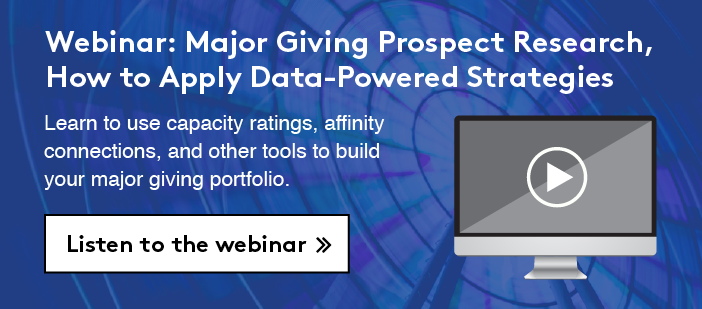Related Articles
Subscribe to the Greater Public newsletter to stay updated.
This site is protected by reCAPTCHA and the Google Privacy Policy and Terms of Service apply.

As major giving programs become more important to the overall revenue picture at public media organizations, it is critical to run these programs as efficiently as possible. A key tool for many successful major giving programs is prospect research. Simply put, prospect research is a formal and organized way of determining whether or not a person is a good major gift prospect.
This kind of vetting is commonly used by hospitals and universities. Investments in prospect research aren’t as common in public media because stations tend to start their major giving programs at a lower level of giving ($1,000 or $2,500). As we in public media set our sights on higher levels of giving and conduct more relationship-based major gifts work, the benefits of prospect research become much more pronounced. Prospect research delivers the information and context that major gift officers need in order to do their job efficiently and strategically.
What Is Prospect Research?
Prospect identification and research: discovering and evaluating prospective donors and their interest, relationships, inclination to give and philanthropic capacity to inform and support an organization’s fundraising strategies and outreach efforts.
– Apra (Association for Prospect Development)
Prospect research is most often thought of as a simple wealth screening tool where a company does an electronic sweep of all or part of a database and assigns a wealth score or grouping to donors. Prospect research then goes beyond wealth screening to develop a more well-rounded picture of a donor’s possible interest in an organization and in philanthropy, as well as their financial capacity for a charitable gift. Prospect research can be used to find new major giving or planned giving prospects from your current database, manage new prospects as they are discovered, sort through the volume of data you uncover, build major giving portfolios for new gift officers, and help giving officers identify the priority for donor outreach.
What Does Prospect Research Look For?
A good prospect has a combination of financial capacity, affinity to your organization, philanthropic inclination, and connection to your organization or relationship to the people in it. If just one of these things is true for a person, it does not make that person a major gift prospect. Just because there is a wealthy donor in your community doesn’t mean they should be on your gift officer’s discovery portfolio. They need to have some affinity, connection, or relationship to your organization or cause. Prospect research can help discover many of these elements so your gift officers can prioritize their work and ask for the right gift at the right time.
[Continued below…]
Prospect Research to Estimate Capacity Ratings
Prospect research can produce an objective assessment of how much a constituent could give over a five-year period based on their public assets and philanthropic history. A prospect researcher determines a capacity rating by looking for visible assets then choosing a wealth estimator formula, often applying a percentage between 2%-5% of wealth estimation and that becomes the donor’s capacity rating. This capacity rating captures the total size of a gift a prospect is capable of giving over a three-to-five-year period, not specifically the capacity to give to your organization. Capacity ratings are also not an estimate of net wealth. They give you a starting place to engage a prospect about a gift. It is then the work of cultivation to develop an understanding of a constituent beyond the capacity rating in order to know if you have a prospect who fits for your organization at this moment in time.
Prospect Research to Find Affinity and Philanthropic Inclination
Skilled prospect researchers will always look at obvious connections first. Start with donors in your database who have given smaller donations but have a larger capacity rating. Similarly, if a prospect has made donations to another public media station in another location, that signals an affinity connection. Get creative by looking for donors in your local community who give to like-minded or partner programs such as youth education, democracy-promotion, art and music programs, etc. Looking for connections to board members, station volunteers, or staff members can help tremendously as your gift officer begins to connect with the prospect.
Prospect Research Can Build Predictive Models
Predictive models help an organization focus a variety of information sources to discover if someone is inclined to give to give to you. These models use statistics to score a group of records in order to see trends in data. They give you an indication of the likelihood that someone will make a gift to you based on certain behaviors and their financial capacity, so you can narrow down a sea of prospects in order to prioritize work for your major gifts officer(s). It’s costly and difficult to train a staff member to create predictive models for your station, so it’s typically a service outsourced to a vendor.
Predictive models are best at removing the people who are NOT good prospects. Most models have an 85% success rate. These models allow you to customize your affinity types to closely match your organization so you can find the donors who are most likely to give to you, instead of to your local university, for example.
Finally, you’ll have the option to choose the threshold amount for major gifts at your station. Many companies default to $100,000 or more. You can stipulate a lower threshold like $10,000 or even lower.


New to Greater Public? Create an account.